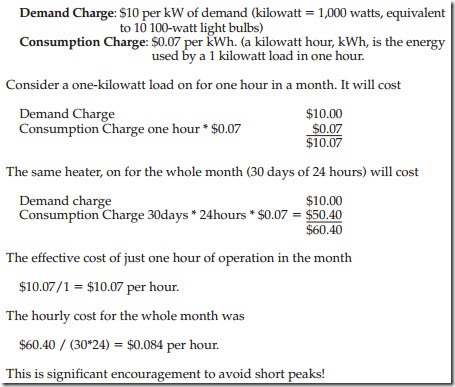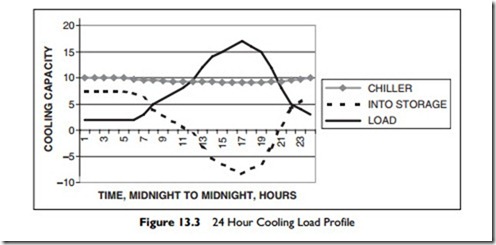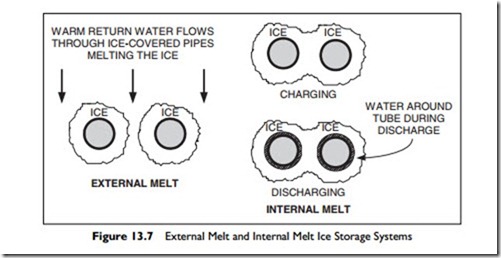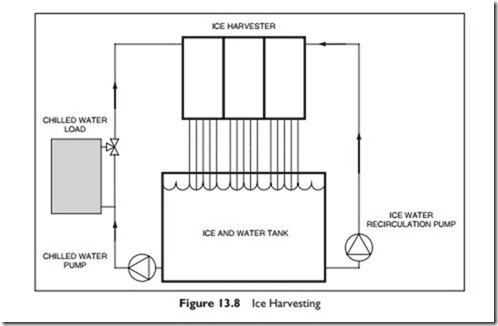Thermal Storage Systems
Thermal storage systems normally involve the generation of cooling or heating, or both, at off hours while storing this energy for use at a later time, generally to be discharged during peak energy use periods such that overall energy costs are reduced. These systems can be “active” or “passive”.
Passive Thermal Storage
“Passive Thermal Storage” refers to using some part of the building mass, or contents, to store heating or to store cooling capacity. The very simplest form of passive storage is the choice to construct a building using heavy construction; block walls, block partitions, concrete floors, and concrete roof decks.
During the cooling season, the mass of the building walls and roof can be cooled at night by the air conditioning system, and when favorable, by the cool night air. When the night air is sufficiently cool, then ventilating the building, by either opening the windows or running the ventilation system, can cool the structure. Then, during the day, the sun has to heat the mass of the structure before the inside temperature rises. In addition, the walls and roof have considerable stored heat when the sun goes down and the warm surfaces of roof and wall re-emit a proportion of heat back to the outside.
The interior mass acts as a thermal flywheel, absorbing heat through the day and re-emitting heat through the evening and night. The result is a lower peak cooling load, hence smaller refrigeration equipment is required. In addition, there is a lower total cooling load, due to the heat stored in the day and zre-emitted outside during the night.
Passive water heating is also very popular in warmer climates. A black plastic water-storage tank on the roof will absorb heat through the day, warming the water. If this solar-warmed water is used for the domestic hot- water supply, to wash basins, and for the cold-water supply, to the showers, then hot water is not needed for hand-washing or cool showers. For a hot shower, the already warmed water must be additionally heated by a conventional water heater. This system has the further advantage of operating at low pressure. The system is very energy-efficient but there is the potential hazard of breeding legionella (see Chapter 4) in the solar-warmed storage tank.
There are many excellent books detailing the variations on solar-heated water storage and using the building to store, or reject, solar heat. One word of caution: the local climate makes a huge difference to the overall effectiveness of a solar heating project. For instance, in a climate where the temperature never drops to freezing, water systems need no protection against freezing. In climates where the temperature does drop to freezing, there are two issues to face: first is the shorter proportion of the year when the system can be used, and second, freeze protection is always more challenging than you would expect, so consult with an expert.
Active Thermal Storage
Active thermal storage takes place when a material is specifically cooled or heated, with the object of using the cooling or heating effect at a later time.
Perhaps the simplest example is the electric thermal storage (ETS) heater, called a ‘brick’ or ‘block storage’ heater in certain parts of the world. These units are commonly used in residences to provide off-peak electric power for heating. The ETS consists of an insulated metal casing filled with high-density magnetite or magnesite blocks. A central electric heater heats the blocks to a temperature as high as 1400°F during off-peak hours, during the night. The units passively discharge through the day and may have a fan to boost output when needed—particularly in late afternoon towards the end of their discharge period.
The units are relatively inexpensive, and, with suitable electrical rate incentives, ETS provide an effective way for a utility to move residential electric heating loads from the day to the night. This allows the utility to level their load, which is almost always to the utility’s benefit. This benefit also lowers the energy cost for the consumer, a true win-win situation.
Since the issue of electrical rate structures has been introduced, this is perhaps a good moment to review some of their more typical features.
Electricity Rate Structures
Virtually all electric-utilities must have users for the power they produce at the moment they produce it. Unlike gas, electricity cannot be stored for later use. Electricity has its highest demand period during the weekdays and, in air-conditioned climates, primarily in the afternoon. In order to serve the peak, the utility must have that installed capacity available. That peak capacity sits idle the rest of the day, earning no revenue.
The following description is of a basic electrical rate structure, though there are many other features applied to encourage a balance between the particular utility and their users.
Consumption Charge and Demand Charge
To balance their costs and income, utilities use two methods of charging those with high peaks in their load. The high peaks are addressed by a “demand charge”. The demand charge is, typically, based on the highest load in any 5–15 minute period in the month. The utility meter is continually checking the average load over the previous few minutes and record- ing the highest peak demand. In addition to the demand charge the utility charges a consumption charge based on the quantity of electricity used. This consumption charge covers all the costs of production.
For example, each month, a utility charges for electricity based on two factors:
Large peaks are easily produced with larger chillers. On one campus, the maintenance staff decided to test run two 1,000-ton chillers on a weekday in early spring, the last day of the month. They wanted to make sure the chillers would be ready when the weather warmed up. Adding the two chillers’ demand charge for the test run cost over $21,000, simply because the chillers pushed the peak demand up for the month!
Time-of-use Rate Schedule
Next, the utility may have a “time-of-use” rate schedule. Earlier we mentioned that low rates encourage the use of night-storage heating through the use of electric-storage heaters. On the other hand, many utilities will charge a hefty premium for power between, for example, noon and 5 p.m. Here the utility is aiming to discourage use in this specific time period in order to minimize their peak.
Both peak demand and time-of-use pricing structures favor the use of thermal storage. In addition, many utilities will give substantial financial incentives to designs that reduce peak demand on their systems. It is always worth checking on what is available and whether the utility will provide financial incentives to help with design in order to maximize savings.
Chilled Water and Ice Storage Systems Introduction
Now we are going to move on from passive storage systems and our discussion on electricity rates to consider water and ice storage systems. Why go to the extra effort to use storage? There are two common reasons: to reduce installation costs where possible and to reduce operating costs. Storage is also being increasingly used as emergency cooling capacity for critical installations, such as computer data centers.
1. To reduce installation costs:
Consider a specialized-use building, like a church, that has a cooling system designed for the capacity based on the peak attendance that occurs one day a week. For the remainder of the week, though, small attendance is the norm. A small cooling plant and storage system may be much less costly to install and, generally, less costly in electricity bills.
Consider Figure 13.3. The chiller is shown running continuously producing almost ten units of cooling capacity. The solid line is the load on a particular day. Starting at the left, midnight, the chiller is serving the load—about 2 units—and the spare capacity is charging the storage. At about 13:00, the load equals chiller capacity and from then until 21:00, the load over-and-above chiller capacity is met from storage. Effectively, the excess chiller capacity at night has been stored for use during the high load in the afternoon.
In some situations this lower installation cost may be achieved even with full daily usage. Factors that can contribute include: smaller chiller, smaller electrical supply, a financial incentive from the utility, and, when ice is the storage medium, even smaller pumps, pipes, fans and ducts are possible.
2. To reduce operating costs:
We have already discussed demand and time-of-day pricing structures that encourage night-time use and discourage afternoon use. As demonstrated, it can be worthwhile to run the chiller during the night and on weekends to avoid demand charges, and overnight and in the morning to avoid time-of-use charges.
Chilled Water Storage
Let’s consider water first. Water holds 1 Btu/lb for every 1°F change in temperature. If our stored water is available at 41°F and return temperature from the cooling coils is 56°F, then every pound will have a storage capacity of 56 Btu – 41 Btu = 15 Btu. A cubic foot of water weighs 62.4 lbs, so a cubic foot of our stored water represents:
In fact, it will require 10% to 50% more, since there are the inevitable losses in the system as the water is pumped in and out, as well as heat gains through the insulated tank wall.
Chilled-water storage is generally conducted with normal, or slightly lower than normal, chilled-water supply temperatures. As a result, producing chilled water for storage can be done using a standard chiller running at approximately the same efficiencies used for conventional chilled-water systems. Chilled-water storage systems tend to dominate the large-system market with tanks that have capacities of half a million cubic feet and more.
Now, let’s consider the use of ice for thermal storage. One cannot make and store a solid block of ice; one needs a mechanism to get the heat in and out. For the sake of example, let’s assume 70% of our storage volume is ice and our system simply recovers the “latent heat of fusion”. The latent heat of fusion of water is 144Btu/lb, which is the heat absorbed to melt one pound of ice or convert one pound of water to ice at 32°F. The latent heat of fusion of 1ft3 of ice is 144 Btu/lb · 62.4 lb/ft3 = 8986Btu/ft3.
In our example, only 70% of the volume can be ice, so the latent heat of fusion storage would be
8,986 Btu/ft3 · 0.7 = 6290 Btu/ft3.
This means chilled water requires about four to seven times the storage volume that ice requires for the same amount of cool storage volume. So, the big advantage of using ice storage is that a much smaller volume of storage is required. However, to achieve this small volume, the chiller must produce much lower discharge temperatures, below 30°F, instead of 40°F, so the chiller efficiency is lower. In addition, the production and handling of an ice storage system generally requires a more sophisticated plant. This smaller space requirement makes ice storage generally more popular for single buildings.
As a result, (to be very simplistic) there is a choice between:
1. Water: A relatively simple and more efficient chilled-water production with larger storage-space requirements.
or
2. Ice: A relatively more complex system with a less efficient chiller, producing
ice and using a smaller storage space requirements.
These underused techniques of water and ice storage are clearly explained in considerable detail in ASHRAE’s Design Guide for Cool Thermal Storage.
In the next sections, we will discuss the basics of practical water and ice storage systems.
Chilled-water Storage
Storing chilled water is normally done in a large stratified tank, cold at the bottom and warmer at the top. Stratification is required to avoid mixing warmer and cooler water while the tank is charged and discharged. Conveniently, water has a maximum density at 39.2°F. So, water that is warmer than 39.2°F will float above water that is at 39.2°F.
Chiller water enters the bottom of the tank, at low velocity, through a dif- fuser, as shown in Figure 13.4. Typically, the diffuser is a loop, or an array of pipes with slots, to allow the water in or out with minimal directional velocity, to minimize mixing. The chilled water enters at 40°F (just above 39.2°F) and the warmer water at the top stays stratified above the 40°F water. As more warm water is pumped from the top of the tank, through the chiller, and returned very gently to the bottom of the tank, the cold layer gradually moves up the tank. When discharging, chilled water is withdrawn at the bottom of the tank and an equal volume of warmed water is returned to the top of the tank. A similar diffuser at the top of the tank minimizes turbulent motion and mixing in the water. The process produces a thermal gradient in the tank, such as shown on the right of Figure 13.4.
In Figure 13.5, a simple circuit is shown with the loads and chiller-circuits below the water level of the storage tank. Valves to control the flows between tank and chiller are not shown in Figure 13.5, since there are several alternatives. There are two pipe-loops connected to the storage tank: one belongs to the
chiller and the chiller pump, and the other is the load circuit, consisting of the variable volume pump, and variable flow loads.
There are up to six possible operating conditions with a storage system, as shown in Figure 13.6.
To maximize savings, the designer must give special consideration to the control of larger storage systems. The seasons when full tank capacity is not required are a particular challenge. On one hand, it is wasteful to over store. On the other hand, if you under store, then you could be faced with much higher electricity charges, or a lack of sufficient capacity at peak load periods. Because these penalties are usually much more costly than any savings that could be achieved by reducing storage, full storage is generally used.
For maximum storage, the temperature difference between the chilled-water supply and return water must be as large as possible. In general, chilled-water storage is not economical with a temperature differential below 12°F. A storage temperature difference of 20°F should be the target to make the system as economical as possible..
Chilled-water storage is not high-tech. Water tanks are a common item in both steel and concrete and the controls do not have to be very complex. Chiller efficiencies are, often, lower because of the lower chilled-water supply temperature required. (Remember from Chapter 6, Section 6–3, the efficiency of a refrigeration circuit falls as the difference in temperature between evaporator and condenser increases.) However, the chiller efficiency that can be achieved is maximized, since the chiller can always run at full load and the operation is largely at night when ambient temperatures around the cooling towers are lower, allowing a lower condenser-water supply-temperature. Efficiency can also be improved by using a larger cooling tower, which will drop the condenser-water supply-temperature Exposed tanks should be insulated to minimize heat gain to the cooled stored water. The size of the storage tank should allow for:
heat transfer and mixing between warm and cold water levels ambient heat gain pumping power The net useful cooling output typically varies between 80% and 90% of the input cooling.
One particularly effective use of chilled-water storage is in the capacity extension of existing facilities.
For example: suppose the client has a building that is running well and needs a substantial addition. You could choose to buy additional chiller capacity for the additional load. Alternatively, it may be far more economical, on space, installation cost and operating cost, to add chilled-water storage and have the existing plant run more continuously through the evening, to serve the increased load.
Ice Storage
There are four main methods of generating ice for ice storage systems: coils, with external melt; coils, with internal melt; ice harvesting; and water in numerous plastic containers.
In External melt systems, ice forms around coil of pipe in a tank. The coils are cooled, and may be steel or plastic. Just two of the pipes in the coil are shown in Figure 13.7. The pipes are spaced so that when fully charged with, for example, 2.5 inches of radial ice, there is still space for chilled water to flow between the iced pipes.
In Internal melt systems the pipes are closer together and cold brine—water containing an antifreeze chemical—passes through the pipes, which causes a block of ice to form around the pipes. To discharge, warm brine passes through the pipes melting the ice around them.
Ice harvesting systems generally have a set of vertical flat, hollow panels above a tank of water, as indicated in the schematic, Figure 13.8. The panels cycle between two functions, first as a chiller evaporator, and then as a condenser, just like the heat pump circuit we discussed in Chapter 6.
The process begins with the panels acting as the chiller evaporator: Water, is continuously pumped over the plates and a layer of ice begins to form on the plates. After 20–30 minutes the ice reaches an optimum thickness and the refrigerant cycle is reversed. Then the panels act as the condenser: The hot condenser gas then melts the ice at the plate surface and it falls into the tank.
Ice harvesting systems are attractive since they can be purchased as factory designed-and-built systems. If needed, they can have a very high discharge rate, and the full 24-hour charge can be removed in as little as half an hour.
Cooling is removed by passing return chilled water through the ice harvester and ice-water storage tank to achieve a chilled-water supply temperature of 34–36°F. This is much colder than the 42°F, or warmer, water from standard chilled-water systems, even those using chilled-water storage.
Lastly, water can be contained in plastic spheres. The spheres are either partially filled with water with some air to allow for expansion on freezing or the spheres have depressions which fill out as the water expands, as it freezes.
In these systems, chilled water containing an antifreeze flows through a tank full of these spheres, to either store or extract cooling.
The major advantages of ice-storage systems are smaller storage tanks and lower chilled-water supply temperatures. The lower chilled-water supply temperatures can be used to increase the system water-temperature differentials and to produce very cool, low temperature, supply-air for distribution to the building’s occupied spaces. This results in smaller pipes and smaller air-distribution ducts and supply-air fans. The low-temperature air-supply system does require carefully designed diffusers that do not dump cold air onto the occupants.
The cooler chilled-water supply temperature from ice storage can be very useful in extending an existing chilled-water system. Suppose there are several buildings on a main chilled-water loop and the client wants to add another building at the end, farthest from the chilled-water plant. The option of increasing the chilled-water pipe-size may be prohibitively costly and disruptive. By adding ice-storage, the chilled-water supply-temperature can be reduced from 42°F to 35°F. If the original system was designed for 42°F chilled-water supply and 55°F return, the temperature rise was
With the same volume flow, the capacity of the piping mains has been increased by 50%, which now allows this system’s pipes to serve the remote building without replacing them with larger pipes. Adding insulation to the existing pipes may be needed.
To achieve the projected savings in energy costs, if the system is not fully automated, the operating staff must completely understand and be able to apply the control strategies of the design. With today’s technology, these can be performed by Direct Digital Controls (DDC), through software. Using DDC, the control sequences can be made fully automatic and therefore, less dependent on the operating staff. However, this does require that these systems be commissioned to ensure that the automatic control functions as intended.
Be warned that it is surprising how often operating and maintenance staff defeat the cleverest software by switching just one piece of equipment to ‘manual’!
There are several other, less popular, active storage methods that you can research elsewhere. Be aware that ‘less popular’ does not mean ‘unpopular’. Many systems are ideal choices for some specific situations but are not practi- cal for every project. Local knowledge and your research can help find the best choice for your project.








